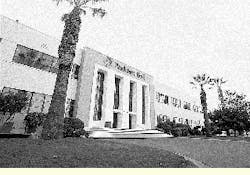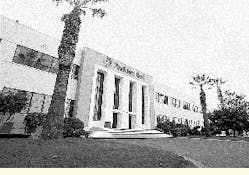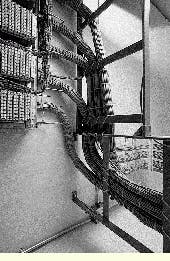When Packard Bell Electronics Inc. moved into a former army depot, Semans Communications had three months to design and install the campus cabling.
Andy Pluister, Belden Wire & Cable Co.
What do you do with a World War II-era U.S. Army depot that the government has shuttered and declared surplus? Packard Bell Electronics Inc. turned it into a high-technology administrative and manufacturing center.
When the 1994 Southern California earthquake hit, it destroyed a major portion of Packard Bell`s administrative and manufacturing facilities. To keep up with customer orders and replace its shattered facilities, the company acquired and moved much of its U.S. operations into a vacant army depot in Sacramento, CA.
For Semans Communications Inc. (Sacramento), the good news was that it won the contract to install the new cabling plant; the bad news was that approximately 800,000 square feet of office and manufacturing space had to be cabled--installed, terminated, tested and ready for occupancy--in three months.
Packard Bell currently occupies 18 buildings on the approximately 1.8-million-square-foot facility for administration and manufacturing/assembly. Each of the buildings is connected by a campus-wide local area network incorporating approximately 3000 nodes. The network uses switched Ethernet with 48 nodes per segment, which is switched to four fiber distributed data interface rings with FDDI bridging or switching between the segments.
Semans Communications installed a network that accommodates voice, video and data transmissions, and one that is also adaptable for the future. The decision was made to use fiber as a backbone with a Belden-Krone Highband Link to the desk.
Square clay conduits
One of the first tasks to be accomplished in converting the empty base into an advanced headquarters/manufacturing facility was to strip out the existing cabling plant and install a state-of-the-art system that would serve the company`s present and future needs. According to installation supervisor Donny Walker, Semans Communications decided to use the existing conduit system that ran throughout the campus rather than trench a new one. This would save money and speed up the cabling process.
However, this decision also led to the first of several problems that are often encountered when existing structures are recabled. "The existing pathways were really old technology," explains Walker. "In fact, the main system consists of square clay conduits, which we were able to re-use. To make space available in the pathways, we had to pull out a lot of old cables, including some 1-inch rigid coaxial cable from the video backbone.
"Of course, this was easier said than done. We actually had to bore and ream some of the conduit going into the main building. When we pulled out the old underground cables, we attached ropes behind them and then pulled our new cables in. It took some work, but the result worked."
All-fiber backbone
The next decision was to use fiber-optic cable for the backbone to provide voice, video and data connections to all of the buildings. The company`s private branch exchange also runs through the fiber-optic cable. Because Packard Bell wanted to use the existing infrastructure whenever possible, the fiber-optic cable runs were installed in existing conduit underground, and the above-ground runs were installed on existing poles.
From the main hub for the computer and telephone network, Semans Communications installed one 72-strand fiber-optic cable to seven buildings and one 12-strand fiber-optic cable to five other buildings. Three 72-strand fiber-optic cables were also installed from the main hub to the security building and, from this building, one 12-strand ring runs between the four manufacturing/assembly buildings for disaster recovery. In addition, six 12-strand fiber-optic cables were run from the security building to six other buildings. From the 72-fiber main distribution frame in each of the manufacturing/assembly buildings, five 12-strand fiber-optic cables cable were pulled to different locations within the buildings for individual distribution frames.
The installers terminated all the fiber-optic cable in the campus-wide network with ultraviolet epoxy-cured SC connectors.
From Ethernet to ATM
From the intermediate frames to the desktop Semans Communications installed Belden Data Twist 350 unshielded twisted-pair, or UTP, cable, Krone Highband wire-termination blocks and Convergence Category 5 information outlets. Data Twist 350 UTP cable allows stable electrical performance to 350 megahertz. Walker says that noise, in addition to performance, was a factor in the selection of this cable, "which is designed to be less susceptible to radio-frequency interference. This is important in a manufacturing area."
"To date, we`ve installed more than 1.8 million feet of Data Twist 350 cable," says Walker. "Although Packard Bell is not using 100 MHz at this campus yet, it expects to soon. And the system we`ve installed will achieve this bandwidth without any problems. This cabling solution should take Packard Bell into any desktop application--any network from 10 megabits per second to asynchronous transfer mode at 155 Mbits/sec." Walker adds that "Packard Bell can do this at this facility because of the [fiber-optic] backbone and the cabling system that we ran to all the stations."
Electronic information travels in the campus-wide installation from the hub to the desktop or testing site in the manufacturing facility using the following signal path:
- As the signal leaves the main building, it travels on fiber-optic cable to an administrative or manufacturing building.
- From this building, its path is on fiber-optic cable to a hub and then to the 25-pair termination blocks that crossconnect to the Highband blocks.
- Next, it travels via UTP cable to the station, then to the RJ-45 jack and, finally, to the computer.
Asbestos and solutions
When a cabling system is installed in older buildings, asbestos is frequently encountered, and Packard Bell`s new facility was no exception. To address this, Semans Communications used 12-inch cable trays for all the cables pulled in the retrofitted buildings. Because of the existence of asbestos within the ceiling, the trays were installed below the ceiling. By using cable trays, any future work on the cabling can be accomplished without disturbing the asbestos in the ceiling.
In the administrative buildings, the UTP cable was installed from the trays via pipes to station outlets. In the manufacturing/assembly buildings, it was a different story. Walker describes the interior of these buildings as "a huge spider web of conveyor belts, and the structure supporting the belts covered most of the inside of the buildings."
He explains that "our job here was to run cables to the different testing and monitoring stations located throughout the buildings. We solved this dilemma by using the existing conveyor structures as pathways for the cables. From the cable trays, we tied the cables to the structure and then routed them to the proper sites on the manufacturing floor."
The manufacturing/assembly buildings presented yet another challenge: Because of the space constraints caused by the conveyor structures and the potential growth envisioned, the computer company did not want to install the intermediate distribution racks or cabinets on the floor where they would protrude into the manufacturing area. "Packard Bell expressed concern that the cabinets would eat up too much space," says Walker. "That space is vital for the conveyor systems, and the company wanted every inch of available space in the manufacturing area."
Semans Communications` solution was to mount all the data termination blocks on plywood sheets affixed to the wall of the building. This design brought the cable to 19-inch frames on the walls above the conveyors. The intermediate distribution frame locations do not have any cabinets; everything is wall-mounted. As a result, the entire building floor space is available for manufacturing purposes. Packard Bell can also reconfigure its manufacturing/ assembly operations without having to work around or move these cabinets.
Packard Bell`s administration building on its new campus in Sacramento, CA.
To save space in the manufacturing area, cable was punched down on wall-mounted termination blocks.
Andy Pluister is product development engineer, Premise Wiring Products, at Belden Wire & Cable Co., Richmond, IN.


